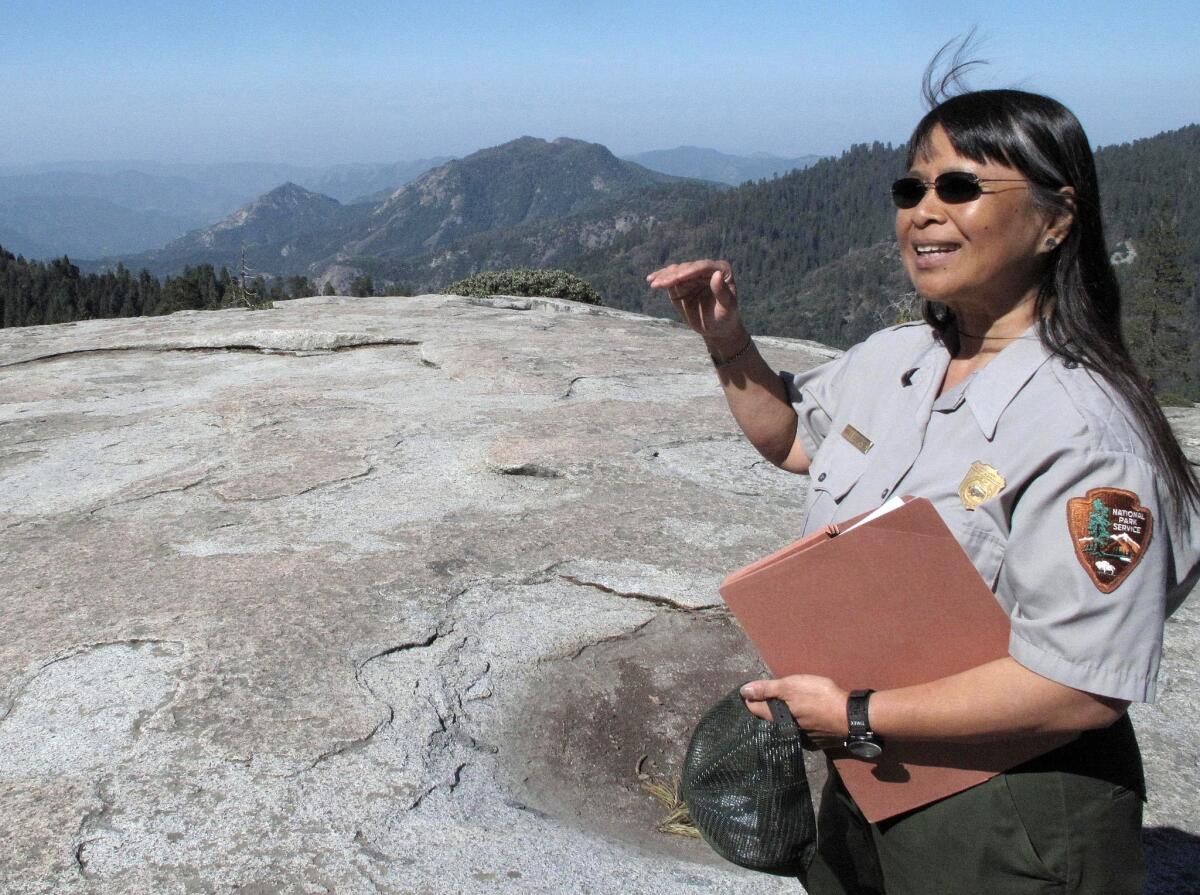An ‘F’ in air quality: California national parks top the list for worst pollution

Sequoia National Park air resource specialist Annie Esperanza explains how ozone diminishes the view from Beetle Rock.
- Share via
Laura Doughty didn’t expect the smog she associates with Las Vegas summers to follow her on vacation.
But during a visit to Sequoia and Kings Canyon National Parks this week, the high school biology teacher found the vistas from Beetle Rock — a scenic overlook near the Giant Forest — obscured.
It was air pollution, a placard informed her, building up against the mountains and fouling what should have been a spectacular view.
“It would have been really cool to look out and see as far as you could,” she said. “It’s sad that the viewpoint is marred by what we have done with cars and power plants and everything else.”
Doughty’s disappointment echoed a report Tuesday by a conservation group that found some of the country’s most popular national parks are plagued by polluted air and hazy skies — and are decades behind schedule getting rid of them.
The National Parks Conservation Assn. flunked Sequoia, Kings Canyon, Joshua Tree and Yosemite in California — giving each park an F for routinely having unhealthful levels of ozone during the summer season, when millions of vacationers descend.
The air quality at Sequoia and Kings Canyon was rated worst in the nation.
The advocacy group, using federal data from 2008 to 2012, assigned grades to each of the 48 national parks that the government has mandated must have the purest air in the nation. It assessed levels of haze and ozone — a lung-damaging pollutant in smog — and documented how each park had been affected by climate change, including rising temperatures and shifts in precipitation.
Three-quarters of the parks had ozone levels considered moderate or worse, the report found, and all 48 had been degraded by haze created by a stew of particles and gases that scatter light and limit visibility.
At Sequoia and Kings Canyon, visitors should be able to see 90 miles farther than they can, the report said. On average at the parks, haze blocks 50 miles of scenery.
Under the U.S. Environmental Protection Agency’s regional haze rule, states must restore the clarity of more than 150 national parks and wilderness areas to natural levels by 2064. Recent projections show many are off-track by decades. And loopholes have allowed coal-fired power plants and other polluters to get by with inadequate emissions controls and other mitigation measures, the report said.
In Joshua Tree, natural visibility is not expected to be achieved until 2106.
To speed progress, the conservation group recommended strengthening the federal regulation.
“Our analysis shows [it is] really too flexible and lacks benchmarks to hold states accountable,” said Ulla Reeves, manager of the National Parks Conservation Assn.’s clean air campaign. “If the regional haze rule is not improved, in 50 years only 10% of our national parks that are required to have clean air will actually have it.”
In a statement Tuesday, the EPA said, “We will continue to assess and improve the regional haze program” as states work toward meeting their goals. In the eastern U.S., the agency said, visibility on the haziest days improved an average of 25% from 2000 to 2012.
The pollutant that poses the most widespread health risk to national park visitors is ozone, the same ingredient in Los Angeles’ smog. The corrosive gas — which builds up in the air when pollutants from cars, trucks, power plants and factories bake in the heat and sunlight — can trigger asthma attacks and cause other respiratory problems. It also is damaging to trees and plants.
Although ozone has declined dramatically in cities in recent decades in response to emissions-cutting regulations, it poses a special challenge for national parks: It can be pushed by the wind over long distances and into high-elevation areas far from major pollution sources.
Recent measurements show that the most-polluted parks have cleaner air than the smoggiest areas of Southern California.
But not by much.
In 2014, Sequoia’s Ash Mountain monitoring station recorded violations of the 75-parts-per-billion federal health standard for ozone on 56 days, including half the month of July. Joshua Tree’s Black Rock monitoring site logged 41 bad ozone days last year, with concentrations as high as 96 parts per billion.
By comparison, the South Coast air basin — which includes Los Angeles, Orange, Riverside and San Bernardino counties — logged 92 bad air days for ozone in 2014, with areas of the Inland Empire and San Bernardino Mountains exceeding 100 parts per billion on the smoggiest summer days.
In much of the country, reduced visibility at national parks and wilderness areas is caused largely by pollution from coal-fired power plants. California’s parks are fouled by a wider variety of sources, including millions of vehicles that emit smog-forming gases and particles, and dairy farms in the Central Valley that release haze-generating ammonia.
G. Dan Mitchell, a community college faculty member and photographer from San Jose, said there is a silver lining to the smog he often encounters on backpacking trips — spilling up into the foothills and obscuring views in Sequoia National Park: “It’s not pretty stuff, but it can make for a nice sunset if you’re facing west. Nothing like backlit smog to light up the sky.”
Hoy: Léa esta historia en español
For more news on air quality and the environment, follow me @tonybarboza
ALSO:
Photos: The 20 most-visited national parks in the U.S.
Air quality rules tightened after cancer risk found to be 3 times higher
Drought making California’s air quality worse, American Lung Assn. says
Rocky Mountain resorts race to defend their businesses against climate change
More to Read
Sign up for Essential California
The most important California stories and recommendations in your inbox every morning.
You may occasionally receive promotional content from the Los Angeles Times.














